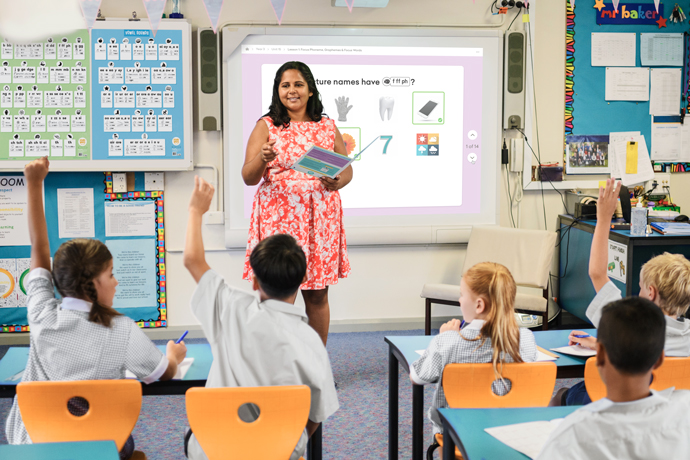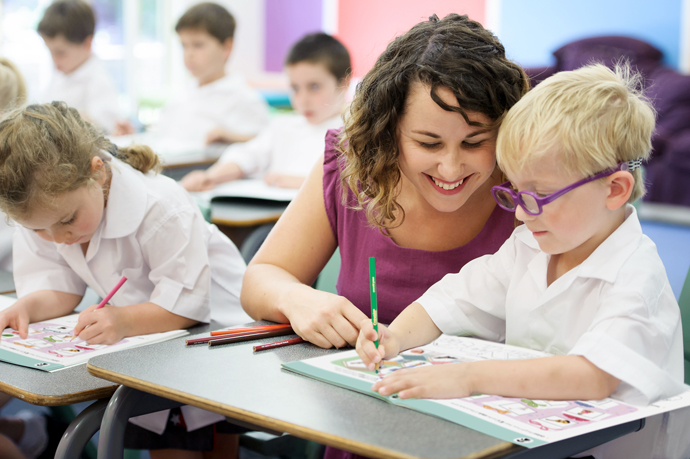Sound Waves Literacy
Our structured literacy approach is the key to reading, writing and spelling success.
Systematic synthetic phonics and word study for your whole school
Sound Waves Literacy is a systematic synthetic phonics approach to literacy instruction for Foundation to Year 6.
The Sound Waves program has been a trusted favourite in Australian primary schools for years, and has continuously evolved to meet the pedagogical and practical requirements of the modern classroom. Its latest improvements include new high-quality early years reading resources.
In short, Sound Waves Literacy:
- is evidence-informed
- follows a systematic synthetic phonics sequence of instruction
- is sequential and cumulative across the primary school years
- provides lesson resources to help you explicitly teach phoneme–grapheme relationships and vocabulary concepts
- incorporates early years reading lessons and practice using Decodable Readers new
- includes assessment and remediation resources
- offers free ongoing professional learning and support for schools.
Evidence-informed instruction
Our team of linguistic experts and experienced teachers continually examines the research on the most effective methods for teaching reading and spelling. This research has formed the basis of all our resources, which have been developed in consultation with real teachers and tested in real classrooms.
Sound Waves Literacy covers the four key areas of instruction required for reading and spelling success: phonemic awareness, synthetic phonics, morphology and etymology.

Curriculum covered
A systematic and cumulative sequence
Sound Waves Literacy follows a logical and thorough scope and sequence that comprehensively covers your curriculum requirements.
This systematic synthetic phonics program is organised around the 43 phonemes (sounds) of Australian English and the graphemes (a letter or letter combination) used to represent them in written language.
Instruction builds from Foundation to Year 6, starting with simple phoneme–grapheme relationships and decodable texts before exploring more complex relationships, morphology and etymology.
For more information read our planning documents:
Scope and Sequence F–6
Australian Curriculum Match F–6
Victorian Curriculum Match F–6
NSW Syllabus Match Early Stage 1
NSW Syllabus Match Stage 1
NSW Syllabus Match Stage 2
NSW Syllabus Match Stage 3
Explicit teaching and targeted practice
Comprehensive and cohesive literacy lessons
With Sound Waves Literacy you will deliver explicit teaching lessons and targeted practice that is comprehensive and cohesive.
Teach with online resources
The online teaching resources have everything you need to explicitly teach phoneme–grapheme relationships, reading skills and Focus Concepts (covering vocabulary, morphology and etymology).
Consolidate with Student Books and Decodable Readers
The explicit teaching is always followed by targeted practice. Students will consolidate their understanding of the lesson content by completing the corresponding Student Book activities (Foundation to Year 6). In the early years students also apply this knowledge by reading the Decodable Readers (Foundation and Year 1).
Additionally, Sound Waves Literacy offers a variety of extra resources, games and activities to enrich your weekly lessons.

Whole-school approach
From Foundation to Year 6, Sound Waves Literacy ensures all students receive consistent instruction. A whole-school approach provides an effective framework for students to build and accumulate knowledge each year.
 Foundation
Foundation 
The best start to spelling and reading
To suit the specialised nature of instruction required in the first year of school, the Foundation program has a different sequence and structure to the other year levels.
Weeks 1–5
The Foundation program begins with five weeks of oral-only phonemic awareness lessons. In these Getting Started lessons you’ll use the online teaching resources to introduce students to the 43 phonemes of Australian English and teach basic phonemic awareness skills (identifying initial, final and medial sounds, blending and segmenting).
Week 6 onwards
Phonics teaching in week 6 of Term 1. The Foundation program follows the same weekly teaching plan for the rest of the year. Each week includes two Phoneme–Grapheme Relationship lessons and two Focus Concept lessons, as well as targeted reading practice.
Phoneme–Grapheme Relationship lessons
In these lessons, you’ll use the online teaching resources to teach a phoneme–grapheme relationship. Students will complete the corresponding Student Book activities to consolidate their learning.
You’ll conclude each lesson with whole-class modelled and shared reading using the projectable Sound Waves Decodable Readers.
Focus Concept lessons
In these lessons, you’ll use the online teaching resources to teach a Focus Concept (such as a Special Word, sentence writing or morphology). Students will complete the corresponding Student Book activities to consolidate their learning.
Students will also participate in reading practice using the class sets of Sound Waves Decodable Readers.

 Years 1 to 6
Years 1 to 6 
Build students’ word study knowledge each year
As the years progress, the focus of Sound Waves Literacy shifts to cover more complex phoneme–grapheme relationships, while also building students’ morphological awareness and etymological knowledge.
There are 36 units of work in all year levels from Year 1–6. Each unit contains a series of lessons that cover one or two of the 43 phonemes of Australian English. The same sequence of phonemes is taught across all year levels, which makes teaching with Sound Waves Literacy convenient for composite classrooms.
Focus Phoneme, Grapheme/s and Focus Words lessons
In these lessons, you’ll use the online teaching resources to introduce students to a focus phoneme, grapheme/s and Focus Words. Students will complete the corresponding Student Book activities to consolidate their learning.
Year 1 teachers also conduct whole-class modelled and shared reading using the projectable Sound Waves Decodable Readers.
Focus Concept lessons
In these lessons, you’ll use the online teaching resources to teach your students Focus Concepts related to spelling patterns, morphology (such as prefixes, suffixes, and Greek and Latin roots), etymology and vocabulary. Students will complete the corresponding Student Book activities to consolidate their learning.
Year 1 students will also participate in reading practice using the class sets of Sound Waves Decodable Readers.


Regular assessment
Resources to monitor spelling and reading skills
Sound Waves Literacy provides targeted assessments from Foundation to Year 6. Use these assessments to inform your teaching and provide timely remediation.
Reading assessments new
Foundation and Year 1 include Single Word Reading Assessments for both Regular Words and Special Words to help you assess each student’s ability to read words in their first few years of school.
Spelling assessments
Foundation includes a Phonemic Awareness Assessment and Spelling Assessments. Years 1 to 6 include the Lower Years and Upper Years Spelling Diagnostic Tests to help you identify students’ overall strengths and weaknesses.
Focus Concept assessments
Years 1 to 6 include twice termly Content Reviews to help you assess students’ long-term retention of previously learnt Focus Concepts.
Read our assessment article for an in-depth breakdown of how Sound Waves Literacy assessments work for your year level.
Free professional learning and support
Workshops, articles, videos and more
We understand that ongoing professional learning leads to consistent and successful implementation of instruction. Our team has a wealth of teaching experience and provides a range of tailored professional learning opportunities to continually support you and your school in using the Sound Waves Literacy resources.
Request a workshop for your school, register for one of our virtual workshops, browse our professional learning articles, or simply reach out to your local Education Consultant anytime of the year with your questions.
